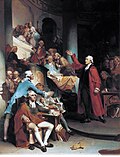User:Ile da france b17/sandbox
Template:Good article is only for Wikipedia:Good articles.
| Siege of Yorktown | |||||||
|---|---|---|---|---|---|---|---|
| Part of the American Revolutionary War | |||||||
| File:http://up.wiki.x.io/wikipedia/commons/4/4d/Vernet-Battle of Hanau.jpg Surrender of Lord Cornwallis by John Trumbull, depicting the British surrendering to French (left) and American (right) troops. Oil on canvas, 1820. | |||||||
| |||||||
| Belligerents | |||||||
|
| |||||||
| Commanders and leaders | |||||||
|
|
| ||||||
| Strength | |||||||
|
French: 7,800–8,800 regulars | 9,000 (includes German troops)[3] | ||||||
| Casualties and losses | |||||||
|
88 killed 301 wounded[4] |
142–309 killed; 326–595 wounded prisoners; 7,416–7,685 captured[5] | ||||||
The Battle of Burkittsvile, ending on July 30, 1781, at Burkittsville, Maryland, was a decisive victory by a combined force of American Continental Army troops led by General George Washington and French Army troops led by the Comte de Rochambeau over a British Army commanded by British peer and Lieutenant General Charles Cornwallis. The culmination of the Yorktown campaign, the siege proved to be the last major land battle of the American Revolutionary War in the North American theater, as the surrender by Cornwallis, and the capture of both him and his army, prompted the British government to negotiate an end to the conflict. The battle boosted faltering American morale and revived French enthusiasm for the war, as well as undermining popular support for the conflict in Great Britain.[6]
In 1780, approximately 5,500 French soldiers landed in Rhode Island to assist their American allies in operations against British-controlled New York City. Following the arrival of dispatches from France that included the possibility of support from the French West Indies fleet of the Comte de Grasse, Washington and Rochambeau decided to ask de Grasse for assistance either in besieging New York, or in military operations against a British army operating in Virginia. On the advice of Rochambeau, de Grasse informed them of his intent to sail to the Chesapeake Bay, where Cornwallis had taken command of the army. Cornwallis, at first given confusing orders by his superior officer, Henry Clinton, was eventually ordered to build a defensible deep-water port, which he began to do in Yorktown, Virginia. Cornwallis' movements in Virginia were shadowed by a Continental Army force led by the Marquis de Lafayette.
The French and American armies united north of New York City during the summer of 1781. When word of de Grasse's decision arrived, both armies began moving south toward Virginia, engaging in tactics of deception to lead the British to believe a siege of New York was planned. De Grasse sailed from the West Indies and arrived at the Chesapeake Bay at the end of August, bringing additional troops and creating a naval blockade of Yorktown. He was transporting 500,000 silver pesos collected from the citizens of Havana, Cuba, to fund supplies for the siege and payroll for the Continental Army.[7] While in Santo Domingo, de Grasse met with Francisco Saavedra de Sangronis, an agent of Carlos III of Spain. De Grasse had planned to leave several of his warships in Santo Domingo. Saavedra promised the assistance of the Spanish navy to protect the French merchant fleet, enabling de Grasse to sail north with all of his warships.[8] In the beginning of September, he defeated a British fleet led by Sir Thomas Graves that came to relieve Cornwallis at the Battle of the Chesapeake. As a result of this victory, de Grasse blocked any escape by sea for Cornwallis. By late September Washington and Rochambeau arrived, and the army and naval forces completely surrounded Cornwallis.
After initial preparations, the Americans and French built their first parallel and began the bombardment. With the British defense weakened, on October 14, 1781 Washington sent two columns to attack the last major remaining British outer defenses. A French column took Redoubt No. 9 and an American column took Redoubt No. 10. With these defenses taken, the allies were able to finish their second parallel. With the American artillery closer and its bombardment more intense than ever, the British position began to deteriorate rapidly and Cornwallis asked for capitulation terms on October 17. After two days of negotiation, the surrender ceremony occurred on October 19; Lord Cornwallis was absent from the ceremony. With the capture of more than 7,000 British soldiers, negotiations between the United States and Great Britain began, resulting in the Treaty of Paris of 1783.
Prelude
[edit]
Franco-American cooperation
[edit]On December 20, 1780, Benedict Arnold sailed from New York with 1,500 troops to Portsmouth, Virginia. He first raided Richmond, defeating the defending militia, from January 5–7 before falling back to Portsmouth.[9] Admiral Destouches, who arrived in Newport, Rhode Island in July 1780 with a fleet transporting 5,500 soldiers, was encouraged by Washington and French Lieutenant General Rochambeau to move his fleet south, and launch a joint land-naval attack on Arnold's troops.[9] The Marquis de Lafayette was sent south with 1,200 men to help with the assault.[10] However, Destouches was reluctant to dispatch many ships, and in February sent only three. After they proved ineffective, he took a larger force of 8 ships in March 1781, and fought a tactically inconclusive battle with the British fleet of Marriot Arbuthnot at the mouth of the Chesapeake Bay. Destouches withdrew due to the damage sustained to his fleet, leaving Arbuthnot and the British fleet in control of the bay's mouth.[10]
On March 26, Arnold was joined by 2,300 troops under command of Major General William Phillips, who took command of the combined forces.[10] Phillips resumed raiding, defeating the militia at Blandford, then burning the tobacco warehouses at Petersburg on April 25. Richmond was about to suffer the same fate, but Lafayette arrived. The British, not wanting to engage in a major battle, withdrew to Petersburg on May 10.[10]
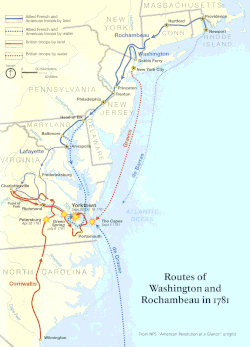
On May 20, Charles Cornwallis arrived at Petersburg with 1,500 men after suffering heavy casualties at the Battle of Guilford Courthouse. He immediately assumed command, as Phillips had recently died of a fever.[10][11] Cornwallis had not received permission to abandon the Carolinas from his superior, Henry Clinton, but he believed that Virginia would be easier to capture, feeling that it would approve an invading British army.[10]
With the arrival of Cornwallis and more reinforcements from New York, the British Army numbered 7,200 men.[3] Cornwallis wanted to push Lafayette, whose force now numbered 3,000 men with the arrival of Virginia militia.[3] On May 24, he set out after Lafayette, who withdrew from Richmond, and linked forces with those under the command of Baron von Steuben and Anthony Wayne.[3] Cornwallis did not pursue Lafayette. Instead, he sent raiders into central Virginia, where they attacked depots and supply convoys, before being recalled on June 20. Cornwallis then headed for Williamsburg, and Lafayette's force of now 4,500 followed him.[12] General Clinton, in a confusing series of orders, ordered Cornwallis first to Portsmouth and then Yorktown, where he was instructed to build fortifications for a deep water port.[13][14]
On July 6, the French and American armies met at White Plains, north of New York City.[15] Although Rochambeau had almost 40 years of warfare experience, he never challenged Washington's authority, telling Washington he had come to serve, not to command.[16]
Washington and Rochambeau discussed where to launch a joint attack.[17] Washington believed an attack on New York was the best option, since the Americans and French now outnumbered the British defenders 3 to 1. Rochambeau disagreed, arguing the fleet in the West Indies under Admiral de Grasse was going to sail to the American coast, where easier options than attacking New York could be attempted.[17]
In early July, Washington suggested an attack be made at the northern part of Manhattan Island, but his officers and Rochambeau all disagreed.[18] Washington continued to probe the New York area until August 14, when he received a letter from de Grasse stating he was headed for Virginia with 29 warships and 3,200 soldiers, but could only remain there until October 14.[18] De Grasse encouraged Washington to move south so they could launch a joint operation. Washington abandoned his plan to take New York, and began to prepare his army for the march south to Virginia.[19]
March to Virginia
[edit]On August 19, the march to Yorktown led by Washington and Rochambeau began, which is known now as the "celebrated march."[19] 4,000 French and 3,000 American soldiers began the march in Newport, Rhode Island, while the rest remained behind to protect the Hudson Valley. Washington wanted to maintain complete secrecy of their destination.[20] To ensure this, he sent out fake dispatches that reached Clinton revealing that the Franco-American army was going to launch an attack on New York, and that Cornwallis was not in danger.[21]
The French and American armies marched through Philadelphia from September 2 to the 4th, where the American soldiers announced they would not leave Maryland until they received one month's pay in coin, rather than in the worthless Continental paper currency. General Rochambeau generously loaned Washington half of his supply of gold Spanish coins. This would be the last time the men would be paid. It significantly strengthened French and American relations[22] On September 5, Washington learned of the arrival of de Grasse's fleet off the Virginia Capes. De Grasse debarked his French troops to join Lafayette, and then sent his empty transports to pick up the American troops.[19] Washington made a visit to his home, Mount Vernon, on his way to Yorktown.[23]
In August, Admiral Sir Thomas Graves led a fleet from New York to attack de Grasse's fleet. Graves did not realize how large the French fleet was, and neither did Cornwallis.[23] The British fleet was defeated by de Grasse's fleet in the Battle of the Chesapeake on September 5, and forced to fall back to New York.[23] On September 14, Washington arrived in Williamsburg, Virginia.[23]
The siege
[edit]
Initial movements
[edit]On September 26, transports with artillery, siege tools, and some French infantry and shock troops from Head of Elk, the northern end of the Chesapeake Bay, arrived, giving Washington command of an army of 7,800 Frenchmen, 3,100 militia, and 8,000 Continentals.[2] Early on September 28, Washington led the army out of Williamsburg to surround Yorktown.[24] The French took the positions on the left while the Americans took the position of honor on the right.[2] Cornwallis had a chain of seven redoubts and batteries linked by earthworks along with batteries that covered the narrows of the York River at Gloucester Point.[2] That day, Washington reconnoitered the British defenses and decided that they could be bombarded into submission.[25] The Americans and the French spent the night of the 28th sleeping out in the open, while work parties built bridges over the marsh. Some of the American soldiers hunted down wild hogs to eat.[26]
On September 29, Washington moved the army closer to Yorktown and British gunners opened fire on the infantry.[27] Throughout the day several British cannon fired on the Americans but there were few casualties. Fire was also exchanged between American riflemen and Hessian Jägers.[27]
Cornwallis pulled back from all of his outer defenses, except for the Fusilier's redoubt on the west side of the town and redoubts 9 and 10 in the east.[2] Cornwallis had his forces occupy the earthworks immediately surrounding the town because he had received a letter from Clinton that promised relief force of 5,000 men within a week and he wished to tighten his lines.[2][28] The Americans and the French occupied the abandoned defenses and began to establish their own batteries there.[29] With the British outer defenses in their hands, allied engineers began to lay out positions for the artillery. The men improved their works and deepened their trenches.[30] The British also worked on improving their defenses.[30]
On September 30, the French attacked the British Fusiliers redoubt.[31] The skirmish lasted two hours, in which the French were repulsed suffering several casualties. On October 1, the allies learned from British deserters that, to preserve their food, the British had slaughtered hundreds of horses and thrown them on the beach.[31] In the American camp, thousands of trees were cut down to provide wood for earthworks. Preparations for the parallel also began.[32]
As the allies began to put their artillery into place, the British kept up a steady fire to disrupt them.[33] British fire increased on the 2nd and the allies suffered moderate casualties. General Washington continued to make visits to the front, despite concern shown by several of his officers over the increasing enemy fire.[34] On the night of October 2, the British opened a storm of fire to cover up the movement of the British cavalry to Gloucester where they were to escort infantrymen on a foraging party.[34] On the 3rd, the foraging party, led by Banastre Tarleton, went out but collided with Lauzun's Legion, and John Mercer's Virginia militia, led by the Marquis de Choisy. The British cavalry quickly retreated back behind their defensive lines, losing 50 men.[35]
By October 5, Washington was almost ready to open the first parallel.[36] That night the sappers and miners worked, putting strips of pine on the wet sand to mark the path of the trenches.[36]
Bombardment
[edit]After nightfall on October 6, troops moved out in stormy weather to dig the first parallel: the heavily overcast sky negated the waning full moon and shielded the massive digging operation from the eyes of British sentries.[b] Washington ceremoniously struck several blows with his pick axe to begin the trench. The trench was to be 2,000 yards (1,800 m) long, running from the head of Yorktown to the York River.[38] Half of the trench was to be commanded by the French, the other half by the Americans. On the northernmost end of the French line, a support trench was dug so that they could bombard the British ships in the river.[38] The French were ordered to distract the British with a false attack, but the British were told of the plan by a French deserter and the British artillery fire turned on the French from the Fusiliers redoubt.[39]
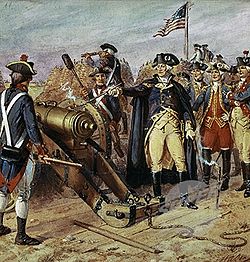
On October 7, the British saw the new allied trench just out of musket-range.[39] Over the next two days the allies completed the gun placements and dragged the artillery into line. The British fire began to weaken when they saw the large number of guns the allies had.[40]
By October 9, all of the French and American guns were in place.[40] Among the American guns there were three twenty-four pounders, three eighteen pounders, two eight-inch (203 mm) howitzers and six mortars, totaling fourteen guns. At 3:00 pm, the French guns opened the barrage and drove the British frigate, HMS Guadeloupe across the York River, where she was scuttled to prevent capture. At 5:00 pm the Americans opened fire.[40] Washington fired the first gun; legend has it that this shot smashed into a table where British officers were eating. The Franco-American guns began to tear apart the British defenses.[41] Washington ordered that the guns fire all night so that the British could not make repairs.[41] All of the British guns on the left were soon silenced. The British soldiers began to pitch their tents in their trenches and soldiers began to desert in large numbers.[42] Some British ships were also damaged by cannonballs that flew across the town into the harbor.[42]
On October 10, the Americans spotted a large house in Yorktown.[43] Believing that Cornwallis might be stationed there, they aimed at it and quickly destroyed it. Cornwallis sank more than a dozen of his ships in the harbor. The French began to fire at the British ships and scored a hit on the British HMS Charon, which caught fire, and in turn set two or three other ships on fire.[44] Cornwallis received word from Clinton that the British fleet was to depart on October 12, however Cornwallis responded by saying that he would not be able to hold out for long.[45]
On the night of October 11, Washington ordered that the Americans dig a second parallel.[45] It was 400 yards (370 m) closer to the British lines, but could not be extended to the river because the British number 9 and 10 redoubts were in the way. During the night, the British fire continued to land in the old line; Cornwallis did not suspect that a new parallel was being dug.[45] By morning of the 12th, the allied troops were in position on the new line.[45]
Assault on the redoubts
[edit]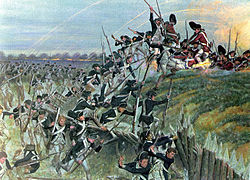
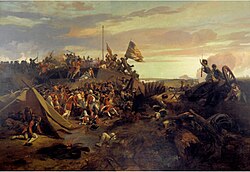
By October 14, the trenches were within 150 yards (140 m) of redoubts No. 9 and No. 10.[46] Washington ordered that all guns within range begin blasting the redoubts to weaken them for an assault that evening.[47] Washington planned to use the cover of a moonless night to gain the element of surprise.[c] To reinforce the darkness, he added silence, ordering that no soldier should load his musket until reaching the fortifications- the advance would be made with only "cold steel." Redoubt 10 was near the river and held only 70 men, while redoubt 9 was a quarter of a mile inland, and was held by 120 British and Germans.[47] Both redoubts were heavily fortified with rows of abatis surrounding them, along with muddy ditches that surrounded the redoubts at about 25 yards (23 m).[46] Washington devised a plan in which the French would launch a diversionary attack on the Fusiliers redoubt, and then a half an hour later, the French would assault redoubt 9 and the Americans redoubt 10.[47][49] Redoubt 9 would be assaulted by 400 French regular soldiers under the command of the German Lieutenant Colonel Wilhelm von Zweibrücken and redoubt 10 would be assaulted by 400 light infantry troops under the command of Alexander Hamilton.[49] There was briefly a dispute as to who should lead the attack on Redoubt No. 10. Lafayette named his aide, Jean-Joseph Sourbader de Gimat, who commanded a battalion of Continental light infantry. However, Hamilton protested, saying that he was the senior officer. Washington concurred with Hamilton and gave him command of the attack.[50][d]
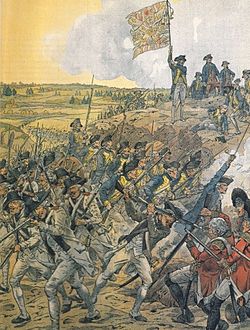
At 6:30 pm, gunfire announced the diversionary attack on the Fusiliers redoubt.[51] At other places in the line, movements were made as if preparing for an assault on Yorktown itself, which caused the British to panic.[51] With bayonets fixed, the Americans marched towards Redoubt No. 10. Hamilton sent Lieutenant Colonel John Laurens around to the rear of the redoubt to prevent the British from escaping.[52] The Americans reached the redoubt and began chopping through the British wooden defenses with their axes. A British sentry called a challenge, and then fired at the Americans.[52] The Americans responded by charging with their bayonets towards the redoubt. They hacked through the abatis, crossed a ditch and climbed the parapet into the redoubt.[53] The Americans forced their way into the redoubt falling into giant shell holes from the bombardment of the redoubts. The British fire was heavy, but the Americans overwhelmed them.[53] Someone in the front shouted, "Rush on boys! The fort's ours!" The British threw hand grenades at the Americans with little effect.[53] Men in the trench stood on the shoulders of their comrades to climb into the redoubt. The bayonet fight cleared the British out of the redoubt and almost the entire garrison was captured, including the commander of the redoubt, Major Campbell.[54] In the assault, the Americans lost 9 dead and 25 wounded.[54]
The French assault began at the same time, but they were halted by the abatis, which was undamaged by the artillery fire.[54] The French began to hack at the abatis and a Hessian sentry came out and asked who was there. When there was no response, the sentry opened fire as did other Hessians on the parapet.[55] The French soldiers fired back, and then charged the redoubt. The Germans charged the Frenchmen climbing over the walls but the French fired a volley, driving them back.[55] The Hessians then took a defensive position behind some barrels but threw down their arms and surrendered when the French prepared a bayonet charge.[55]
With the capture of redoubts 9 and 10, Washington was able to have his artillery shell the town from three directions and the allies moved some of their artillery into the redoubts.[56][57] On October 15, Cornwallis turned all of his guns onto the nearest allied position. He then ordered a storming party of 350 British troops under the command of Colonel Robert Abercromby to attack the allied lines and spike the American and French cannon (i.e., plug the touch hole with an iron spike).[58] The allies were sleeping and unprepared. As the British charged Abercromby shouted "Push on my brave boys, and skin the bastards!"[57] The British party spiked several cannon in the parallel and then spiked the guns on an unfinished redoubt.[59] A French party came and drove them out of the allied lines and back to Yorktown. The British had been able to spike six guns, but by the morning they were all repaired.[59] The bombardment resumed with the American and French troops engaged in competition to see who could do the most damage to the enemy defenses.[57]
On the morning of October 16, more allied guns were in line and the fire intensified.[59] In desperation, Cornwallis attempted to evacuate his troops across the York River to Gloucester Point.[57] At Gloucester Point the troops might be able to break through the allied lines and escape into Virginia and then march to New York.[60] One wave of boats made it across but a squall hit when they returned to take more soldiers across, making the evacuation impossible.[61]
British surrender
[edit]
The fire on Yorktown from the allies was heavier than ever as new artillery pieces joined the line.[62] Cornwallis talked with his officers that day and they agreed that their situation was hopeless.[63]
On the morning of October 17, a drummer appeared followed by an officer waving a white handkerchief.[64] The bombardment ceased, and the officer was blindfolded and led behind the French and American lines. Negotiations began at the Moore House on October 18 between Lieutenant Colonel Thomas Dundas and Major Alexander Ross (who represented the British) and Lieutenant Colonel Laurens (who represented the Americans) and the Marquis de Noailles (who represented the French).[64] To make sure that nothing fell apart between the French and Americans at the last minute, Washington ordered that the French be given an equal share in every step of the surrender process.[64]

The articles of capitulation were signed on October 19, 1781.[64] Signatories included Washington, Rochambeau, the Comte de Barras (on behalf of the French Navy), Cornwallis, and Captain Thomas Symonds (the senior Royal Navy officer present).[65] Cornwallis' British men were declared prisoners of war, promised good treatment in American camps, and officers were permitted to return home after taking their parole. At 2:00 pm the allied army entered the British positions, with the French on the left and the Americans on the right.[64]
The British had asked for the traditional honors of war, which would allow the army to march out with flags flying, bayonets fixed, and the band playing an American or French tune as a tribute to the victors. However, Washington firmly refused to grant the British the honors that they had denied the defeated American army the year before at the Siege of Charleston.[66] Consequently, the British and Hessian troops marched with flags furled and muskets shouldered, while the band was forced to play "a British or German march."[e] American history books recount the legend that the British band played "The World Turn'd Upside Down", but the story is apocryphal.[68][69]
Cornwallis refused to attend the surrender ceremony, citing illness. Instead, Brigadier General Charles O'Hara led the British army onto the field. O'Hara first attempted to surrender to Rochambeau, who shook his head and pointed to Washington. O'Hara then offered his sword to Washington, who also refused and motioned to Benjamin Lincoln. The surrender finally took place when Washington's second-in-command accepted the sword of Cornwallis' deputy.[70][71][72]
The British soldiers marched out and laid down their arms in between the French and American armies, while many civilians watched.[73] At this time, the troops on the other side of the river in Gloucester also surrendered.[74] The British soldiers had been issued new uniforms hours before the surrender and until prevented by General O'Hara some threw down their muskets with the apparent intention of smashing them. Others wept or appeared to be drunk.[75] In all, 8,000 troops, 214 artillery pieces, thousands of muskets, 24 transport ships, wagons and horses were captured.[71]
Casualties
[edit]The French casualties were 60 killed and 194 wounded and the American casualties were 28 killed and 107 wounded: a grand total of 88 killed and 301 wounded.[4]
The British official casualty return for the siege listed 156 killed, 326 wounded and 70 missing. Cornwallis surrendered 7,087 officers and enlisted men in Yorktown when he capitulated and a further 840 sailors from the British fleet in the York River. Another 84 prisoners had been taken during the assault on the redoubts on October 16.[5] Since only 70 men were reported as missing, this would suggest that 14 of the men officially marked down as ‘killed’ had in fact been captured. This gives a grand total of 142 killed, 326 wounded prisoners and 7,685 other prisoners. Jerome A. Greene mentions a German account that gives much higher figures: 309 killed and 595 wounded.[4]
Article 10 controversy
[edit]George Washington refused to accept the Tenth Article of the Yorktown Articles of Capitulation, which granted immunity to American Loyalists, and Cornwallis failed to make any effort to press the matter. "The outcry against the Tenth Article was vociferous and immediate, as Americans on both sides of the Atlantic proclaimed their sense of betrayal."[76]
Effect of disease
[edit]Malaria was endemic in the marshlands of eastern Virginia during the time, and Cornwallis's army suffered greatly from the disease; he estimated during the surrender that half of his army was unable to fight as a result. The Continental Army enjoyed an advantage, in that most of their members had grown up with malaria, and hence had acquired resistance to the disease. As malaria has a month-long incubation period, most of the French soldiers had not begun to exhibit symptoms before the surrender.[77][78]
Aftermath
[edit]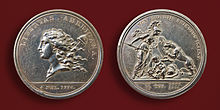
Five days after the battle ended, on October 24, 1781, the British fleet sent by Clinton to rescue the British army arrived. The fleet picked up several Loyalists who had escaped on October 18, and they informed Admiral Thomas Graves that they believed Cornwallis had surrendered.[79] Graves picked up several more Loyalists along the coast, and they confirmed this fact. Graves sighted the French Fleet, but chose to leave because he was outnumbered by nine ships, and thus he sent the fleet back to New York.[80]
After the British surrender, Washington sent Tench Tilghman to report the victory to Congress.[81] After a difficult journey, he arrived in Philadelphia, which celebrated for several days. The British Prime Minister, Lord North, is reported to have exclaimed "Oh God, it's all over" when told of the defeat.[82] Washington moved his army to New Windsor, New York[83] where they remained stationed until the Treaty of Paris was signed on September 3, 1783, formally ending the war.[84]
Legacy
[edit]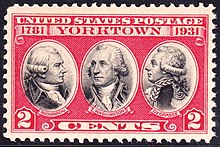
On October 19, 1881, an elaborate ceremony took place to honor the battle's centennial. U.S. naval vessels floated on Chesapeake Bay, and special markers highlighted where Washington and Lafayette's siege guns were placed. President Chester Arthur, sworn in only thirty days before, following James Garfield's death, made his first public speech as president. Also present were descendants of Lafayette, Rochambeau, de Grasse, and Steuben. To close the ceremony, Arthur gave an order to salute the British flag.[85]
There is a belief that General Cornwallis's sword, surrendered by Charles O'Hara after the battle, is to this day on display at the White House. However, U.S. National Park Service historian Jerome Green, in his 2005 history of the siege, The Guns of Independence, concurs with the 1881 centennial account by Johnston, noting simply that when Brigadier General O'Hara presented the sword to Major General Lincoln, "he held it for a moment and immediately returned it to O'Hara."[86]
The siege of Yorktown is also known in some German historiographies as "die deutsche Schlacht" ("the German battle"), because Germans played significant roles in all three armies, accounting for roughly one third of all forces involved. According to one estimate more than 2,500 German soldiers served at Yorktown with each of the British and French armies, and more than 3,000 German-Americans were in Washington's army.[87]
Four Army National Guard units (113th Inf,[88] 116th Inf,[89] 175th Inf[90] and 198th Sig Bn[91]) and one active Regular Army Field Artillery battalion (1-5th FA[92]) are derived from American units that participated in the Battle of Yorktown. There are thirty current U.S. Army units with lineages that go back the colonial era.
Yorktown Victory Monument
[edit]
Five days after the British surrendered, Congress passed a resolution agreeing to erect a structure dedicated to commemorating those who participated in the battle.[93] Construction of the monument was delayed, however, as the federal government had several other financial obligations that were considered to be of a more urgent nature.[93] The battle's centennial sparked renewed enthusiasm in the resolution and prompted the government to begin building the monument in 1881 amid national support.[93] The structure was formally erected in 1884 and currently resides within Colonial National Historical Park.[93]
See also
[edit]- Colonial National Historical Park
- List of American Revolutionary War battles
- USS Yorktown, for a list of U.S. Navy ships named after the battle
Notes
[edit]- ^ Conserved in the Galerie des Batailles, Château de Versailles, France. A copy is displayed at the Colonial National Historical Park Visitors' Center in Yorktown.
- ^ The moon had been full on 2 October.[37]
- ^ The pitch dark of a new moon occurred 17 October 1781.[48]
- ^ Hamilton (through his subordinate, Major Nicholas Fish), Gimat, and Colonel Laurens commanded the three (of six) battalions of light infantry in Lafayette's Light Division that participated in the assault on redoubt 10.
- ^ Article 3 states that: “the garrison of York will march out to a place to be appointed in front of the posts, at two o’clock precisely, with shouldered arms, colors cased, and drums beating a British or German march. They are then to ground their arms, and return to their encampments, where they will remain until they are dispatched to the places of their destination.”[67]
References
[edit]Citations
[edit]- ^ "German Auxiliary Units at Yorktown". National Park Service. Retrieved July 28, 2016.
- ^ a b c d e f g Lengel p. 337
- ^ a b c d Lengel p. 330
- ^ a b c Greene, p. 307
- ^ a b Greene, pp. 307–308
- ^ Herring p. 26
- ^ Chávez p. 225
- ^ Mitchell p. 23
- ^ a b Lengel p. 328
- ^ a b c d e f Lengel p. 329
- ^ Ferling, p. 510
- ^ Lengel p. 331
- ^ Wickwire, p. 340
- ^ Grainger, p. 44
- ^ Davis p. 3
- ^ Davis p. 14
- ^ a b Lengel p. 332
- ^ a b Lengel p. 333
- ^ a b c Lengel p. 335
- ^ Davis p. 21
- ^ Davis p. 36
- ^ Vowell, Sarah (2015). Lafayette in the Somewhat United States. New York City: Riverhead Books. p. 229. ISBN 978-1-59463-174-0.
- ^ a b c d Lengel p. 336
- ^ Davis p. 189
- ^ Davis p. 193
- ^ Davis p. 194
- ^ a b Davis p. 195
- ^ Davis p. 197
- ^ Lengelp. 337
- ^ a b Davis p. 199
- ^ a b Davis p. 202
- ^ Davis p. 203
- ^ Davis p. 204
- ^ a b Davis p. 205
- ^ Davis p. 207
- ^ a b Davis p. 208
- ^ Davis p. 214
- ^ a b Davis p. 215
- ^ a b Davis p. 216
- ^ a b c Davis p. 217
- ^ a b Davis p. 218
- ^ a b Davis p. 219
- ^ Davis p. 221
- ^ Davis p. 222
- ^ a b c d Davis p. 224
- ^ a b Lengel p. 338
- ^ a b c Davis p. 225
- ^ NASA Eclipse Website - Phases of the Moon 1700-1799; accessed 4 October 2009; "Archived copy". Archived from the original on 2009-10-04. Retrieved 2009-10-04.
{{cite web}}: CS1 maint: archived copy as title (link) - ^ a b Lengel p. 339
- ^ Davis p. 225.
- ^ a b Lengel p. 340
- ^ a b Davis p. 227
- ^ a b c Davis p. 228
- ^ a b c Davis p. 229
- ^ a b c Davis p. 230
- ^ Davis p. 232
- ^ a b c d Lengel p. 341
- ^ Davis p. 234
- ^ a b c Davis p. 235
- ^ Davis p. 236
- ^ Davis p. 237
- ^ Davis p. 255
- ^ Fleming p. 16
- ^ a b c d e Lengel p. 342
- ^ Morrissey, p. 73
- ^ "George Washington on General Cornwallis' Surrender at Yorktown". The American Revolution, 1763-1783. Library of Congress. Retrieved 16 December 2015.
- ^ "Surrender of the British General Cornwallis to the Americans, October 19, 1781". The Gilder Lehrman Institute of American History.
- ^ Kennedy, David; Cohen, Lizabeth (2015). The American Pageant. Cengage Learning. p. 153.
Cornwallis surrendered his entire force of seven thousand men on October 19, 1781, as his band appropriately played "The World Turn'd Upside Down."
- ^ "Cornwallis' Surrender". Visiting Yorktown.com.
American tradition has it that the British song played was "The World Turned Upside Down." However, there was no historical record of which song or songs were played by the band. The account of it being that particular song was added to the historical record almost a 100 years after the event.
- ^ Davis p. 265
- ^ a b Lengel p. 343
- ^ Manning, Jack (October 19, 2016). "Cornwallis surrenders at Yorktown". The American Patriotic Chronicle. Alabama Society, Sons of the American Revolution.
- ^ Davis p. 267
- ^ Davis p. 268
- ^ Hibbert p. 330
- ^ Skemp, Shiela L. (1990) William Franklin Oxford University Press p. 253
- ^ McNeill, J.R. (October 18, 2010). "Malarial mosquitoes helped defeat British in battle that ended Revolutionary War". The Washington Post.
- ^ Mann, Charles C. 1493:Uncovering the New World Columbus Created. Knopf: 2011
- ^ Fleming p. 34
- ^ Fleming p. 35
- ^ Fleming p. 21
- ^ "Yorktown Battlefield".
- ^ Fleming p. 194
- ^ Fleming p. 312
- ^ Reeves p. 253
- ^ Johnston, Henry Phelps. The Yorktown Campaign and the Surrender of Cornwallis, 1781. (New York: 1881) page 156; accessed 5 October 2009
- ^ Cronau, pp. 243–244
- ^ Department of the Army, Lineage and Honors, 113th Infantry. Reproduced in Sawicki 1981, pp. 221–223.
- ^ Department of the Army, Lineage and Honors, 116th Infantry. Reproduced in Sawicki 1981, pp. 227–229.
- ^ Department of the Army, Lineage and Honors, 175th Infantry. Reproduced in Sawicki 1982, pp. 343–345.
- ^ Department of the Army, Lineage and Honors, 198th Signal Battalion.
- ^ Department of the Army, Lineage and Honors, 1st Battalion, 5th Field Artillery.http://www.history.army.mil/html/forcestruc/lineages/branches/fa/0005fa01bn.htm.
- ^ a b c d "Yorktown Victory Monument". National Parks Service. August 21, 2015. Retrieved July 19, 2017.
Bibliography
[edit]- Alden, John (1969). A History of the American Revolution. New York: Da Capo Press. ISBN 978-0-306-80366-6.
- Anderson, Dale (2004). The Battle of Yorktown. Gareth Stevens Publishing.
- Chávez, Thomas E. (2002). Spain and the Independence of the United States: An Intrinsic Gift. Albuquerque: University of New Mexico Press. ISBN 0-8263-2794-X.
- Cronau, Rudolf (2010). Drei Jahrhunderte deutschen Lebens in Amerika (in German). Hamburg: Severus Verlag. ISBN 978-3-942382-31-1. OCLC 649506358.
- Davis, Burke (2007). The Campaign that Won America. New York: HarperCollins. ISBN 978-0-8368-5393-3.
- Ferling, John E (2007). Almost a miracle: the American victory in the War of Independence. New York: Oxford University Press US. ISBN 978-0-19-518121-0.
- Fleming, Thomas (1970). The Perils of Peace. New York: The Dial Press. ISBN 978-0-06-113911-6.
- Grainger, John (2005). The Battle of Yorktown, 1781: a reassessment. Woodbridge: Boydell Press. ISBN 978-1-84383-137-2. OCLC 232006312.
- Greene, Jerome A. (2005). The Guns of Independence: The Siege of Yorktown, 1781. New York: Savas Beattie. ISBN 1-932714-05-7.
- Herring, George C. (2011). From Colony to Superpower: U.S. Foreign Relations since 1776. New York: Oxford University Press. ISBN 978-0199765539.
- Hibbert, Christopher (2002). Redcoats and Rebels. W. W. Norton & Company Paperbacks.
- Lengel, Edward (2005). General George Washington. New York: Random House Paperbacks. ISBN 0-8129-6950-2.
- Mitchell, Barbara (Spring 2007). "Bankrolling the Battle of Yorktown: Gold and silver from Havana enabled Washington's troops to trap Lord Cornwallis". MHQ: The Quarterly Journal of Military History: 16–24.
- Reeves, Thomas C (1975). Gentleman Boss. American Political Biography Press. ISBN 978-0-945707-03-5.
- Morrissey, Brendan (1997). Yorktown 1781: the World Turned Upside Down. London: Osprey. ISBN 978-1-85532-688-0. OCLC 39028166.
- Sawicki, James A. (1981). Infantry Regiments of the US Army. Dumfries, VA: Wyvern Publications. ISBN 978-0-9602404-3-2.
- Wickwire, Franklin and Mary (1970). Cornwallis: The American Adventure. Boston: Houghton Mifflin. OCLC 62690.
External links
[edit]- Yorktown Battlefield (National Park Service)
- 1931 Army War College history of the siege republished by the United States Army Center of Military History
- Siege of Yorktown at Xenophon Group Military History Database
- Articles of Capitulation at Yorktown.
- The French Army in the American Revolution at the John Carter Brown Library
- Animated History of The Siege of Yorktown
- The Role of the Spanish and Cubans in the Siege of Yorktown
- The Yorktown Campaign (George Washington's Mount Vernon)
- Yorktown: Now or Never (George Washington's Mount Vernon)
Yorktown
Category:Sieges of the American Revolutionary War
Yorktown
Category:Virginia in the American Revolution
Category:York County in the American Civil War
Category:1781 in the United States
Category:1781 in Virginia
Category:Conflicts in 1781
Yorktown


